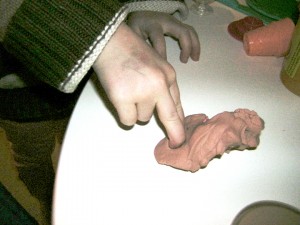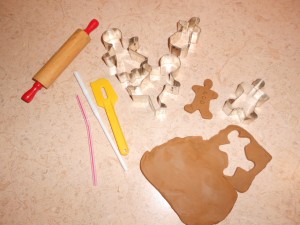If the little hands at your house are finding it hard to wait for Christmas, mix up some special playdough for fun, learning and even kindergarten readiness. Playdough is very affordable and, when kept in the fridge, can last for days.

1. Gingerbread playdough: To your favorite playdough recipe, add some gingerbread spices: 1 Tbsp of cinnamon, 2 tsp of powdered ginger, 1 tsp of cloves, and if you have nutmeg at your house, a sprinkle or two of that.
When ready, put out some gingerbread boy and girl cookie cutters and some tools, like a rolling pin and maybe a straw for making buttons. Watch out that they don’t run away!
 2. For candy canes, it’s fun to make some red playdough and some white with a peppermint smell. Peppermint flavoring, peppermint oil, or even a few broken candy canes crushed up make a nice scent. (If using candy canes, leave a piece or two that are for tasting, because once it’s mixed in the playdough, it’s not for eating anymore.)
2. For candy canes, it’s fun to make some red playdough and some white with a peppermint smell. Peppermint flavoring, peppermint oil, or even a few broken candy canes crushed up make a nice scent. (If using candy canes, leave a piece or two that are for tasting, because once it’s mixed in the playdough, it’s not for eating anymore.)
This doesn’t need cookie cutters because it’s for rolling and twisting together, but after some fun with that, add a few for more fun.
Playdough is obviously good for developing strength and muscles in the hands and fingers. It also helps with other learning, such as:
- sensory play and exploration–what does it feel like in terms of texture, temperature, weight, shapes, etc.
- language–action words such as squeezing, rolling, squishing, patting; colors; shapes; and more for telling about and explaining.
- imagination and creativity–who knows what these gingerbread people might do?
- problem-solving and planning–how can a lump of playdough be turned into gingerbread people?
Playdough can be used for kids of any age, as long as they are past the putting-stuff-in-mouth stage. Besides lots of learning, it’s also mega-fun. Does your child enjoy playdough?
